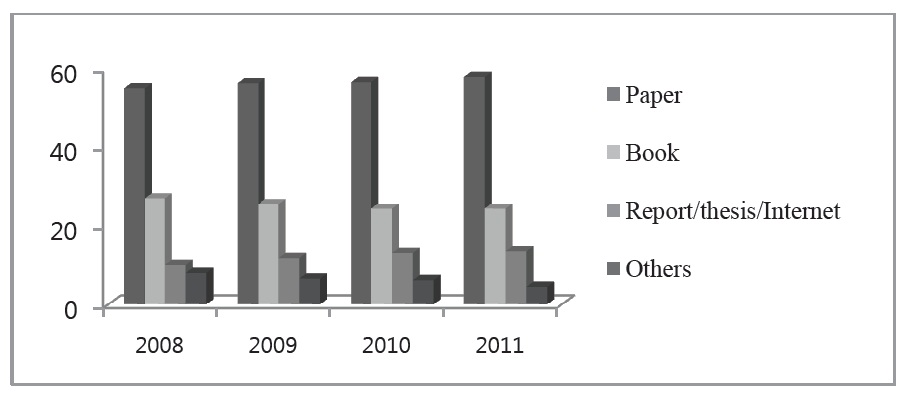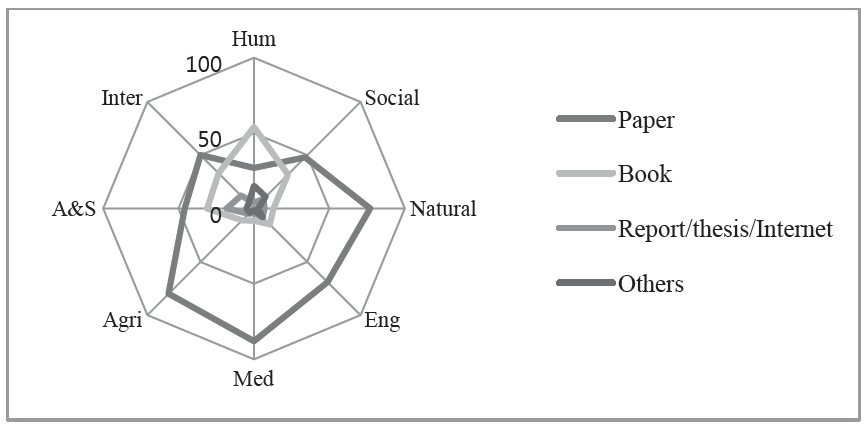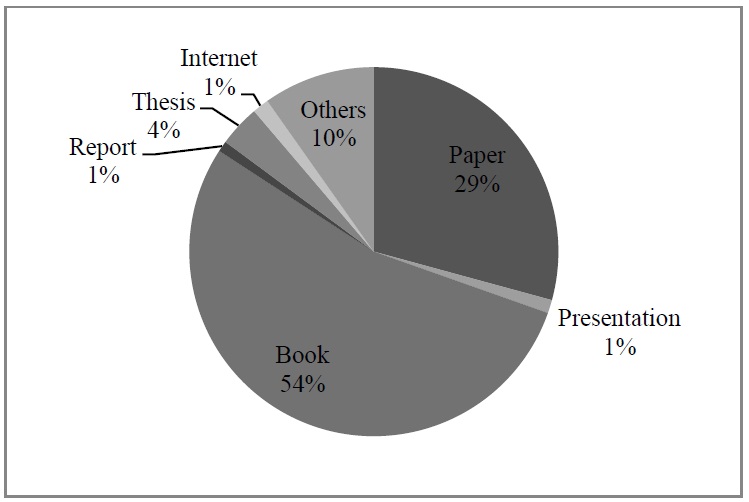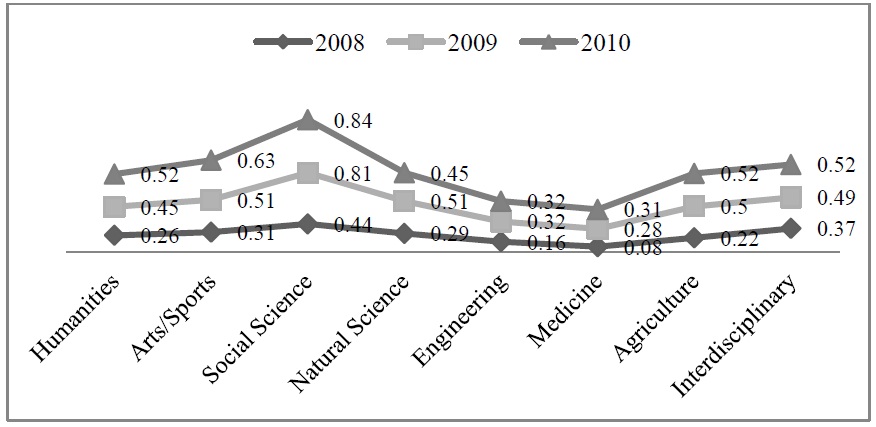



This paper introduces the Korea Citation Index (KCI) and also some macro statistics of KCI. KCI started service since 2008 by the National Research Foundation of Korea (NRF), but the data has been gathered from 1998. Our findings are as follows: heavy reliance on books in humanities, but papers as the main reference in all other disciplines. Impact factor is an increasing trend in all disciplines. Social science has the highest impact factor among all fields. In some fields even in science and engineering areas, there are more KCI papers than Korean JCR papers and impact factors of the KCI are higher than JCR. As for the distinction between nationally and internationally fields or journals, some disciplines in social science are clearly nationally oriented. NSE journals listed in both KCI and JCR, however, are not clear in terms of impact factor, but clear in terms of the numbers of papers.
Since the seminal work of Garfield (1972), citation analysis has become a major scientific evaluation method for scholarly works. His endeavors led to the world leading citation databases of SCI (Science Citation Index), SSCI (Social Science Citation Index) and A&HCI (Arts and Humanities Citation Index). The aggregate data of SCI and SSCI are reported by Journal Citation Reports (hereafter JCR) of Thomson Reuters.
In addition to JCR database, another citation database of SCOPUS by Elsevier appeared in 2004, also becomes a major database. Even so, both are mostly based on English journals. That means the databases mostly supports English writing scholars and journals. Although Thomson Reuters wants to expand their coverage in the Web of Knowledge (for example, 700 regional in 2008), the basic structure remains.
Therefore, many non-English speaking countries, especially countries unaccustomed to English, have wanted to figure out scholars’ performance since the 1990s, resulting in national citation databases. China was the first to build up and service their own citation databases followed by Spain, Japan, Brazil, Taiwan, Korea and India.
Because of history and size, a few studies have analyzed the Chinese Science Citation Database (CSCD) (Rousseau et al., 2001; Leydesdorff and Bihui, 2004; Zhou and Leydesdorff, 2007; Zhou, Su, and Leydesdorff, 2010; Yang et al., 2010; Su, Deng and Shen, 2012). However, only few studies introduced some aspects of non-English journal databases: Meneghini, Mugnaini and Packer (2006) for Brazilian database and Julia et al. (2008) for Spanish database, and a few reports on national citation databases in Japan, Taiwan, India and Korea (Chen, 2004; Negishi, Sun and Shigi, 2004; Rabishankar and Anup, 2011; Ko, Cho and Park, 2011; Choi et al., 2013; Seo, Jung and Kim, 2013).
This paper introduces the Korea Citation Index (KCI) and also some macro statistics of KCI to present new aspects on non-English citation databases. We review existing literature by issue in section 2, and then introduce the overview of KCI with basic statistics. Then, we show several aspects of impact factor on the KCI in section 4, and finalize with discussion. The impact factor in this paper follows the common definition, the average number of citations received per paper published in a journal during the two preceding years.
In macro level analysis of citation statistics, differences between natural science and engineering (here after NSE) and social science and humanities (hereafter SSH) should be kept in mind as denoted by Glänzel & Schoepflin (1999), Van Raan (2003), Larivière et al. (2006).
In particular, Hicks (1999; 2004) pointed out references in social science are diverse encompassing articles, books and reports, differing from that of natural science, which focuses on articles. This indicates SSH has more diverse communication methods than NSE. Archambault et al. (2006) also added some disciplines of SSH are relatively young and no international rule or definition of concept is necessary. In addition, most themes of SSH are local, therefore published in the local language. Nonetheless, he presented a trend of internationalization in SSH based on data from Finnish journals in 1994-2002.
Due to reference coverage, current orthodox databases of JCR and SCOPUS in citation references have a limit in SSH (Cosmopoulous and Pumain, 2007), and a decreasing share in all citation data (Larsen and Von Ins, 2010).
In addition, many studies examine differences of impact factor between fields (Podlubny 2005; Batista et al. 2006; Iglesias and Pecharroman 2007; Fortunatoa and Castellanob, 2008; Adler, Ewing and Taylor, 2009; Lillquist and Green, 2010). In particular, Althouse et al. (2009) showed that impact factor of the same journal has changed over time. If a field develops fast, impact factor trails.
Another issue in citation statistics is the difference between English journals and non-English journals. Ted et al. (2001) and Ren, Zu and Wang (2002) pointed out citation statistics of existing databases are not exact because of the inclusiveness of journals in the database. In particular, journals from China, Russia, Germany and France are not fully included in JCR databases.
Fung (2008) analyzed the issues of citation on non-English papers in English journals of epidemiology. Liang, Rousseau and Zhong (2011) analyzed 352 journals in physics and found two facts: non-English journals receive less citation than English journals even in the same subfield and non- English papers receive fewer citations than English language ones, even in the same journal. They pointed out language barrier as a reason for usage of different databases. Second, researchers fluent in English are accustomed to English journals, so they publish there. Finally, lack of English language skills leads local researchers from observing English papers, resulting in lower quality research.
On the other hand, King (2004) found an interesting fact: citation numbers of each country are closely related to the country income level. Also, Bordons, Fernandez and Gomez (2002) pointed out country differences such as “life sciences-oriented” countries (such as UK) vs. more “technologicallyoriented” ones (Germany or Japan).
Although JCR and SCOPUS dominate citation databases, some countries have their own national level citation database: 4 citation databases in China, Citation Database for Japanese Papers, CINDOC database of Spain, 3 citation databases in Taiwan, SciELO (Scientific Electronic Library on Line, www.scielo.bireme.br) of Brazil and its extension to Chile, Cuba and Venezuela, Korea Citation Index, and Indian Citation Index.
Jin and Wang (1999) introduced the construction process of the Chinese Science Citation Database (CSCD) in 1989, and Chinese Social Science Citation Index (CSSCI) started from 1998 and service from 2000 (Su, Han and Han, 2001; Su, Deng and Shen, 2012). CSCD is managed by the Chinese Academy of Science and CSSCI by Chinese Social Sciences Research Evaluation Center.
Besides, there are two national level databases such as the Chinese Science and Technical Paper and Citation Database (CSTPCD) by Institute of Scientific and Technical Information of China from 1988, and Chinese Humanities and Social Science Citation Database (CHSSCD) by the Chinese Academy of Social Science since 2002. The CSCD and CSSCI are the main Chinese citation databases, as the CSTPCD and CHSSCD are only for statistics.
Because of its history, various studies have been conducted. Rousseau et al. (2001) analyzed the impact factor of CSCD and Leydesdorff and Bihui (2004) analyzed 37 English title journals among 991 in the CSCD.
Zhou and Leydesdorff (2007) analyzed journal-to-journal citations in mathematics, and Zhou, Su, and Leydesdorff (2010) analyzed 3 disciplines in the CSSCI such as political science and Marxism, library and information science, and economics. Their findings are as follows: In 2007, there were 493 CSSCI journals compared to 1,866 in SSCI. Chinese journals in SCI increased sharply during 2000s, but numbers of references in social science were lower than that of SSCI and natural science. The reasons were no specialization in social science and slower development of social science than natural science.
Yang et al. (2010) analyzed 2,338,033 papers in 4 fields such as chemistry, clinical medicine, library information and archival science, and literature and world literature in Chinese Citation Databases spanning 1979- 2008. Their concern was citation concentration of journals, and they found the concentration index of journals fell. That means citation breadth increased.
Meneghini, Mugnaini and Packer (2006) introduced the Brazilian citation database, SciELO, which went online in 1997, and analyzed SciELO journals compared to the JCR-ICI database. SciELO had 144 journals and 50,000 articles by November 2005, which represented about 20% of Brazilian journals and received 80% of the national citations. There were 13 journals commonly listed in SciELO and JCR. Among them, journals in agriculture, veterinary science, public health, and tropical disease got a superior impact factor in SciELO than in JCR. That means some journals, even in natural sciences, are more nationally oriented.
In Spain, The Centre for Scientific Information and Documentation (Centro de Información y Documantación Científica-CINDOC) belongs to the Spanish National Research Council build up citation database in science and technology (former ICYT DB) and Social Sciences and Humanities (former ISOC DB). Besides, Valencia University hosts Biomedicine (IBIM) database. These services started from 1970s and online since 1992.
Julia et al. (2008) analyzed 16 journals listed in Spanish social science and biomedical DB, and also listed in JCR. Among 3,004 journals, 1.06% listed in the JCR DB in 2001-2005: 110 journals (3.66%) from social science DB and 99 journals from biomedical DB (3.29%). Impact factor from JCR was greater than national DB.
Chen (2004) introduced the Taiwan Social Science Citation Index (TSSCI) and the Taiwanese Humanities Citation Index (THCI). Before these 2 databases, Taiwan Science Citation Index started from 1998 by the National Science Council (NSC) of the Republic of China.
Negishi, Sun and Shigi (2004) introduced Citation Database for Japanese Papers (CJP) developed at the National Institute of Informatics (NII), which started in 1995 and serviced from 2000. The database covered all the disciplines unlike other non-English citation indexes, and 1,000 journals among 2,019 journals reported.
Rabishankar and Anup (2011) introduced a new platform of the Indian Citation Index launched in 2010 which is a multidisciplinary database for about 1,000 peer reviewed Indian journals. ICI covers data from 2004 onwards. (http://www.indiancitationindex.com)
Korea also has a citation database titled Korea Citation Index, and it is not a divided discipline-based database, but consolidated like Japan since 1998.
III. Overview of Korea Science Index
A university funding agency of the Korean government started the Listed Journal System in 1998. The Listed Journal means a qualified journal by the government, and the Candidate Journal is a quasi-qualified one that could be qualified in the near future. The selection criteria were timeliness of publication, number of issues per year, number of referees, reference format, rules for papers, and selection principles for referees, etc. The criteria and process to designate the listed journals had been tough; many journals applied for the designation several times. There were 58 listed journals in 1998 and 2,128 as of February 2013, which was the time that the new journal selection ended. Based on this accumulation, the Korea Citation Index (KCI: http://www.kci.go.kr) set-up in 2007 and started service from 2008.
The characteristics of KCI are as follows: First, journal data is gathered automatically. Publishers of each journal should report original materials to the KCI of the National Research Foundation (NRF) of Korea within 7 days after publication, if they want to be continuously listed. Second, the DB is linked to the personal database of the Korea Researcher Information (KRI) DB of NRF, which is a consolidated database of each university’s personal evaluation database. Nearly all 4-year universities and some 2-year colleges link their evaluation databases to the KRI DB on a real time basis. NRF is a powerful funding agency to universities. If a university wants to apply and win research projects or programs, they have to link their databases as data is used for various evaluations by NRF. Third, the quality of the KCI is very high, because the two databases check each other. If a university inputs each researcher’s information to their DB, then the data is automatically transferred to KRI DB, where the data is confirmed. If data is unconfirmed, the DB notifies the university and vice versa.
The number 2,128 can be compared to that of Web of Science of 11,487 (2012.11) and SCOPUS of 20,469 (2012. 5). Among the listed journals, some also listed in the JCR. The entries increased from 10 in 1998 to 111 in 2012.
[Table 1] Qualified journals and source of KCI (2012. 12)

Qualified journals and source of KCI (2012. 12)
Qualified journals as of December 2012 make up 66.8% of the number of academic societies. Journals in interdisciplinary field are the lowest share at 39.2% and natural science and engineering was the top at 74.2%. It is noteworthy that the shares of listed journals in humanities and social science are high.
Journal issues per year differ from discipline to discipline from 1 to 24. The only journal that publishes 24 issues is from civil engineering, which is also listed in JCR. Average yearly issues of humanities/arts/sports, social science, interdisciplinary, and NSE are 2.83, 3.36, 3.6 and 5.18 respectively. Except NSE, yearly issues are below 12 but many journals in NSE have 12 issues per year.
[Table 2] Issues per year by disciplines (%)

Issues per year by disciplines (%)
[Table 3] Average authors and references (2012. 5)

Average authors and references (2012. 5)
Average authors are 2.67, but those of humanities, arts and sports are the lowest with 1.24 and natural and medicine is the highest at 4.65. In average references, engineering is the lowest with 8.7 and social science is the highest with 20.5. However, the number of references widely differs even between fields within social science. For example, comparative articles on innovation studies showed references in Chinese journals numbered 9.1, Korean journals 27.5, and Technovation, a famous English journal 30.5 (Seol and Park, 2008; Seol, Jin and Kwon, 2010).
References of all disciplines are shown in Figure 1. Papers are the main reference followed by books and report, thesis and internet resources. Dependence on papers has been increasing. Also presentation materials, reports, thesis, and Internet resource have been increasing.
References by disciplines are shown in Figure 2. In all disciplines, papers are the main reference followed by books except humanities. Excluding papers and books, the order of other resources is different by disciplines. In engineering, presentation materials are the third resources, but reports/thesis and Internet sources are the third in arts and sports. Dependence on papers is quite high in all science and technology fields, but not so much in other disciplines.
References in humanities quite differ from other disciplines. Figure 3 is the detail composition of references in humanities. In humanities, books are first and papers second. Besides, reliance on other references is quite high compared to other disciplines. Other references include music, drama, painting, and monument etc.
The impact factor of KCI differs between disciplines ranging 0.31 to 0.84. The impact factor of social science is the top followed by arts & sports with 0.63. And those of engineering and medicine are the lowest with 0.31 and 0.32 in 2010. These results differ from general impact factor studies on JCR journals that show NSE higher than SSH. In addition, this result is different from Zhou, Su, and Leydesdorff (2010), which show Chinese social science is lower than NSE.
However, there is a trend of impact factor increasing in every discipline as shown in Figure 3. Several aspects can explain: First, the number of listed journals and papers has increased, so many papers have been exposed to others as shown in table 4. Second, journal quality has periodically been controlled by the NRF, so paper quality and reference quality has improved. Third, database quality has increased enough to catch out small errors linking KRI DB and KCI DB.
[Table 4] Number of listed journals and papers by year

Number of listed journals and papers by year
Even in JCR journals, impact factor over 1.2 is not bad. Those kinds of journals, however, are not few in the KCI DB as 183 in 2010 are shown in table 5. Also, the numbers grew from 13 in 2008. These kinds of journals make up 16% of social sciences and 8% in arts/sports. Journals in social science are 57% of the total. This may come from 1) the current evaluation system of Korean universities which highlights academic papers especially in social science, 2) the number of indexed journals, and 3) the journal evaluation system of the National Research Foundation of Korea.
[Table 5] KCI journals with impact factor over 1.2
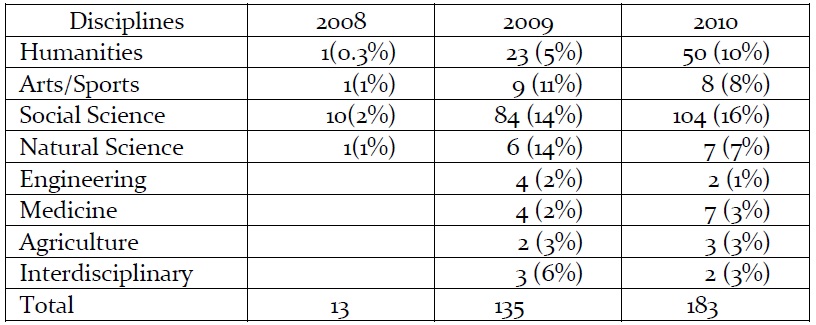
KCI journals with impact factor over 1.2
2. Impact Factor of Humanities Journals
JCR does not give any detail information about humanities. KCI, however, has information on humanities. Table 6 shows the distribution of impact factors in humanities. As time flows, impact factor of humanities has been growing. Impact factors larger than 1.2 are good examples of growing trends: 0.2% in 2008 and 10.0% in 2010.
[Table 6] Impact factor of humanities journals (%)
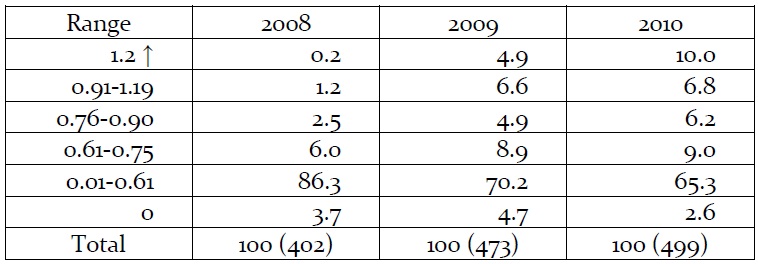
Impact factor of humanities journals (%)
3. Comparison of KCI and JCR Journals by Discipline
If we compare impact factors by discipline between JCR and KCI journals, discipline categories of each database have to be matched. The discipline categories of KCI are from the National Standards for Classification of Science and Technology (Song and Seol, 1999; Seol and Song, 1999). Meanwhile, the categories of JCR are arbitrary to meet the needs of academic societies. In some cases, one discipline category of KCI is matched to several categories of JCR. The two numbers in the JCR row in Table 7 are the minimum and the maximum impact factors of JCR categories are in accordance with the KCI categories.
Table 7 shows the comparison of impact factor between JCR and KCI journals by discipline in social science. Among 13 disciplines in the table, impact factors of 3 disciplines in KCI are higher than those of JCR ranging 0.90 to 1.59. Although tourism in KCI category does not match the JCR category, impact factor is the highest with 1.95. The impact factors of KCI journals compared to JCR journals by disciplines range 42% to 162% in social science.
Table 8 is a comparison of impact factors in science and engineering between JCR and KCI journals. KCI impact factors in science and engineering range from 0.13 to 0.70, but range 0.71-4.96 in JCR. KCI impact factors in science and engineering are 8-59% of JCR journals. The lowest 0.13 (mathematics and nuclear engineering) in KCI journals can be compared to the lowest 0.71 (mathematics) of JCR, and the highest 4.96 (Chemistry, multidisciplinary). These results confirm the analysis of Julia et al. (2008), Liang, Rousseau and Zhong (2011). Generally, impact factor of JCR journals is higher than that of national journals.
[Table 7] Comparison of impact factor in social science (2011)
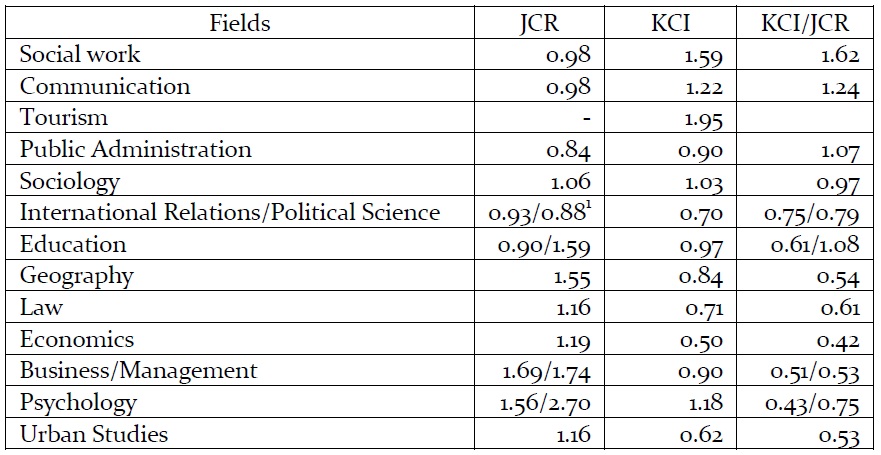
Comparison of impact factor in social science (2011)
[Table 8] Comparison of impact factor in science and engineering (2011)

Comparison of impact factor in science and engineering (2011)
V. Nationally and Internationally Oriented Fields
1. Impact Factor of English journals in both KCI and NCR
Some Korean journals are published in English and listed in the JCR database. Many researchers pointed out that citations from JCR are larger than citations in national journals. Table 9 shows English journals in both KCI and NCR. In natural science, among 13 journals, 2 journals in physics got higher impact factors from KCI than JCR. In engineering, among 27 journals, 3 journals got higher impact factors from KCI than JCR. Even with higher numbers, its absolute size is relatively low compared to those in JCR journals. Therefore, the results suggest no clear distinction.
[Table 9] Impact factor of English journals in both KCI and NCR (2010)
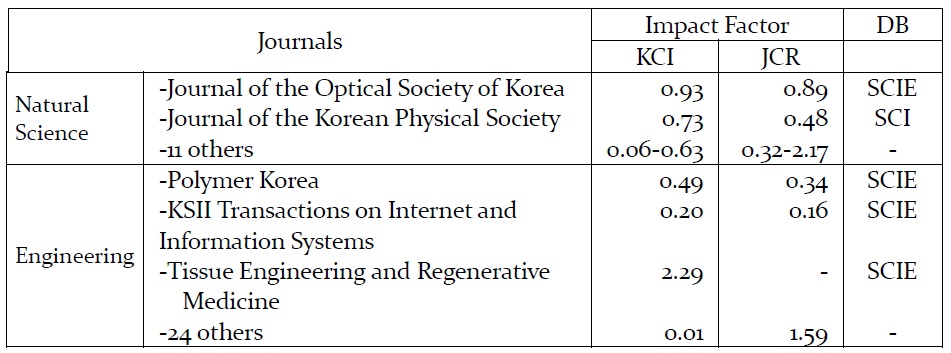
Impact factor of English journals in both KCI and NCR (2010)
2. Comparison of the Number of Papers
Meneghini, Mugnaini and Packer (2006) pointed out that there are nationally oriented fields and internationally oriented fields in the analysis of Brazilian citation databases. Table 8 does not show a clear distinction of nationally oriented fields and internationally oriented fields. Hence, this section discusses the distinction with the number of papers.
The table 10 shows the number of Korean JCR papers and KCI papers in the same category of disciplines. In the table we clearly see there are nationally oriented fields and internationally oriented fields in terms of paper numbers. Social science is the representative nationally oriented field. There are 23.4 times more papers of national orientation in general social science, and 11.3 more times in economics.
In NSE areas, Environment/ecology is the top among national oriented disciplines. JCR papers by Korean are only 25% of KCI papers. JCR papers in agricultural sciences and geosciences are also about 25% respectively, and engineering with 37%. The fields of mathematics, molecular biology & genetics, pharmacology & toxicology, and clinical medicine are also nationally oriented. On the other hand, physics, chemistry, space science, material science, biology, immunology, microbiology, and neuroscience are internationally oriented. Moreover, computer science and plant & animal science are neutral.
[Table 10] Internationally and nationally oriented fields by number of papers (2010)
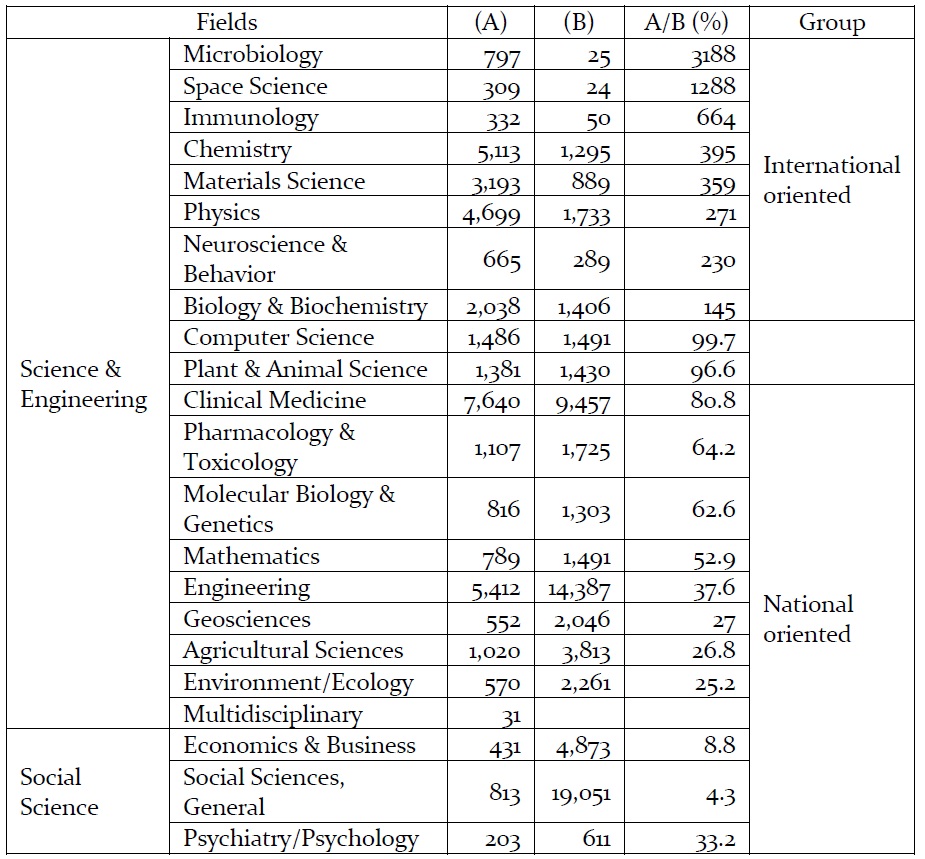
Internationally and nationally oriented fields by number of papers (2010)
JCR provides good comparison data between disciplines, countries and organizations for NSE and social science. The DB, however, does not give detail information on humanities. This paper provides some data on humanities such as references and impact factors from the KCI. The comparison of this data with other countries such as China and Taiwan will provide a good understanding of references in humanities.
As Meneghini, Mugnaini and Packer (2006) pointed out on academic fields, journals can be classified into nationally orientated or internationally orientated. This distinction may come from the specialized demands of a nation or region or academic superiority of the journal and language problems in the case of non-English journals. The results of this study on the distinction between national and international orientation are mixed as shown in the following summary.
Characteristics of KCI
KCI started service since 2008 by the National Research Foundation of Korea (NRF), but the data has been gathered from 1998.
Journal data is gathered automatically. Publishers of each journal should report original materials to the KCI within 7 days after publication.
The DB is linked to the Korea Researcher Information (KRI) DB of NRF, which is a consolidated database of each university’s personal evaluation database.
The quality of the KCI is very high, because the two databases cross checks each other.
Sources
Average authors number 2.67, but those of humanities, arts and sports are the lowest with 1.24, and natural science and medicine is the highest at 4.65.
For average references, engineering is the lowest with 8.7 and social science is the highest with 20.5.
Papers are the main reference followed by books. Dependence on papers has been increasing. However, books are the first amongst references in humanities.
Impact Factor
The impact factor of KCI differs between disciplines ranging 0.31 to 0.84, but the impact factor of each discipline has been increasing, even in humanities.
Journals with impact factor over 1.2 make up 18% of social sciences, 10% in arts/sports, and 7% in humanities.
The impact factors of social science journals range from 0.43-1.62. Among 13 disciplines in social science, the impact factors of the top 3 disciplines in KCI are higher than those of JCR. Those of science and engineering journals, however, are 8-59% of JCR journals.
Nationally and Internationally Oriented Fields
Some disciplines in social science are clearly nationally oriented.
NSE journals listed in both KCI and JCR, however, are not clear in terms of impact factor, but clear in terms of the number of papers.
KCI has been used for inner purpose of the National Research Foundation such as evaluation tools for selection of projects and programs. Therefore, only a few studies using KCI data have been published in English (Ko, Cho and Park, 2011; Ko, 2013).
The unveiling of non-English citation databases may demean the country’s scholarship, because citation data is much lower than JCR data. Citation data, however, is dependent on the size of researchers and difference in the development of each discipline, and may be partly attributable to national income level, as pointed out by King (2004).
We hope other studies using non-English citation databases from China, Spain, Brazil, Japan, Taiwan, and India will be examined. That will help the exchange of experiences, understanding of traditions and the weakness and strength of specific fields. In particular, the identification of nationally oriented fields from non-English journals will boost the world’s knowledge bank.
Finally, this is a description of KCI macro features. Therefore, we welcome diverse microanalysis from other non-English citation databases.



